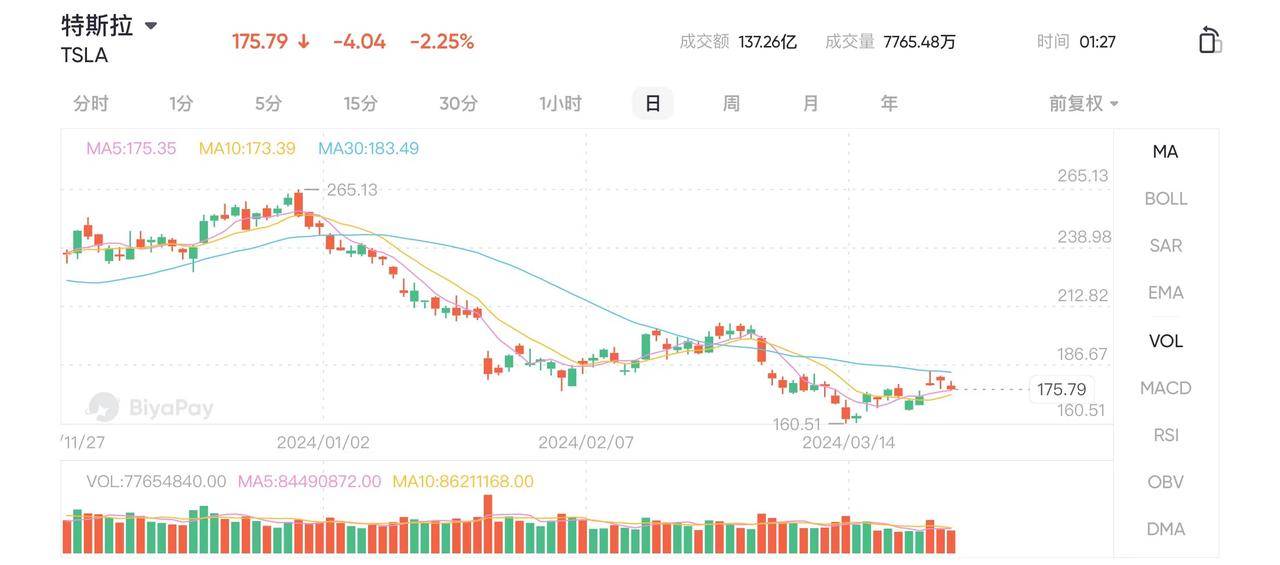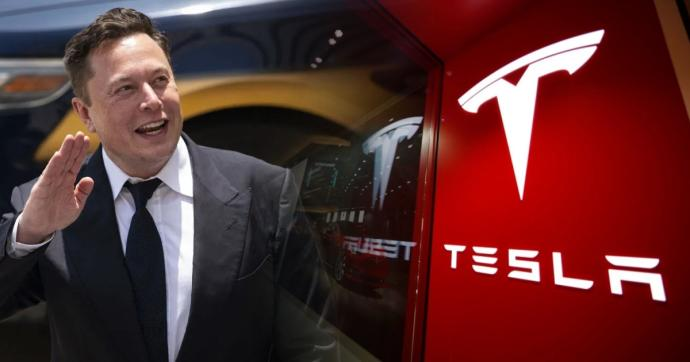- Remittance
- Exchange Rate
- Stock
- Events
- EasyCard
- More
- Download
A Massive $230 Billion Plunge: Is There Hope for This Leading U.S. Stock?
If one were to mention the most disheartening U.S. tech stock this year, Tesla would certainly be on the list.
For Tesla’s investors, the first three months have been undeniably challenging. A decline in electric vehicle demand, intensified market competition, and some unexpected negative news led to a 29% decrease in Tesla’s stock price for the quarter. The vehicle delivery data for the first quarter is seen as a key indicator of the company’s operational status, with Tesla expected to announce its vehicle delivery performance in early April.
When it rains, it pours, as Tesla faced a series of negative events, such as issues at its Berlin factory and Musk’s earlier threat to divest the AI business if he did not receive 25% of the voting rights. Currently, it seems no institution or investor, except perhaps Cathie Wood, dares to be overwhelmingly bullish. Despite Musk’s history of bouncing back from tough times, Tesla’s current predicaments are likely causing him significant distress.
According to data from the BiyaPay App, Tesla’s stock price fell from $248.48 at the end of last year to $175.79 at the end of the first quarter, a decrease of 29.3%. Its market capitalization is now around $559.8 billion, with a loss of $230 billion in the last three months alone. Compared to the 52-week high of $299.29 in July last year, the market cap has evaporated by more than $350 billion.
So, is there hope for Tesla’s stock price?

TSLA market trend, chart source BiyaPay App
Tesla: A Troubled Year
The reasons for Tesla’s stock price decline are well understood.
First, 93% of Tesla’s revenue comes from its car sales, meaning that despite future narratives, Tesla’s earnings are directly tied to how well its cars sell.
Tesla currently has five models on sale: the high-end S and X, the mid-range Cybertruck, and the lower-end 3 and Y. The S and X have high prices and low sales volumes, the Cybertruck has many orders but limited production capacity, and according to Musk, it will only reach a capacity of 250,000 vehicles, about 10% of the total, by 2025. Therefore, models 3 and Y are the real revenue and profit drivers for Tesla.
However, the Model 3 is already seven years old, and although it evolved last year, the changes were not significant. The Model Y, introduced in 2020, has won the global sales crown, but the novelty factor is waning.
As we know, cars are consumer goods, and constant innovation drives revenue growth. One can imagine the situation if Apple still relied only on the iPhone 11 and 12; how would Apple investors feel?
The market’s bearish view on Tesla is due to the severe aging of its current models, with new models not seen until possibly next year, while China’s BYD surpassed Tesla in the fourth quarter of last year, becoming the global leader in electric vehicle sales.
Just a few days ago, Xiaomi launched its first electric vehicle, the SU7, priced at 215,900 yuan, cheaper than Tesla’s Model 3. The next day, Xiaomi announced over 50,000 orders for this electric car within 27 minutes of its launch. Xiaomi’s CEO, Lei Jun, stated that the “SU7 surpasses Tesla’s products in 90% of specifications” and believes that “with five to ten years of effort, Xiaomi will one day surpass Porsche.”
Given these factors, 2024 will be a challenging year for Tesla.
According to predictions from several Wall Street analysts, the average delivery volume for the first quarter is 457,000 vehicles, an 8% increase from the same period last year’s 422,875 vehicles. Analysts estimate deliveries to be between 414,000 and 511,000 vehicles.
If Tesla’s reported delivery performance falls below Wall Street’s average expectations, its stock price may drop further.
Does this mean investors should give up on Tesla?
In reality, Tesla remains a quality company.

Nvidia’s Jensen Huang, a leading figure in the global AI sector, shared an important perspective during an interview at Stanford Business School.
He said the quality of a company should not be judged by its financials, as they are historical indicators and reflect past performance. Instead, one should look at the “early indicators of future success” (EIOFS) to gauge future potential.
We believe that while electric vehicles may face short-term challenges, they are undoubtedly the trend for the future. Some may disagree, as companies like Ford and even countries like the U.S. and European nations have delayed their full electrification timelines, suggesting electrification is not a trend.
However, if electrification were not a trend, it would not be delayed but canceled altogether. If Europe and the U.S. decided to prohibit electric vehicle sales in favor of gasoline cars, one could argue that the electric vehicle trend is incorrect. But the delay indicates that traditional gasoline vehicles are not selling well in these regions.
This gives Tesla an opportunity. In both the U.S. and Europe, Tesla maintains a significant advantage in the automotive market.
In the long run, Tesla is likely to succeed alongside the success of electric vehicles, given Musk’s visionary approach.
How can Tesla turn things around?
One strategy is to cut costs, such as through layoffs, which is a straightforward and effective method.
Production process improvements and economies of scale can also reduce costs, although Musk admits that the current models’ costs are nearing their limit.
Another strategy is to quickly introduce more new models, like the highly anticipated Model 2, which could boost sales due to its lower price and potentially lower costs through economies of scale. Tesla can also expand globally and increase the production and delivery of the Cybertruck.
Accelerating the development of new growth areas, such as FSD, AI cloud services, and robotics, is another strategy.
If Tesla’s autonomous driving capability is achieved, it will have an advantage that others do not have, because it has a lot of cars running on the road, and it uses pure visual routes. By upgrading the software, previous cars can have autonomous driving capabilities. This is something that the LiDAR route does not have. If the original car did not install LiDAR, it had to be reinstalled at the factory to achieve autonomous driving. However, pure vision is not the case. Tesla has long used high definition cameras, which can be called technology pre-embedding. With the software upgrade, millions of cars running on the road can achieve autonomous driving capabilities, which is its unique advantage.
Is it worth buying Tesla now? If judged solely on short-term market conditions, it might not seem worth it due to the ongoing pressures. However, for long-term investment, it could be worthwhile.
Tesla embodies the spirit of extreme innovation, representing one of the world’s top tech innovators. Musk is not one to hastily assemble a product for quick profit. He aims for groundbreaking achievements.
This might be why Tesla experiences lows periodically. In business, the market primarily cares about profits and quarterly financial reports. While grand visions like reaching for the stars are appreciated, they can also lead to ridicule and short selling if the financials are weak.
Investors can manage their assets using multi-asset trading wallets like BiyaPay. If one is hopeful and can afford to wait, the timing of the purchase is not an issue. Real-time trading is available on BiyaPay by searching for its ticker symbol. Investors can deposit cryptocurrencies (U) into BiyaPay and withdraw fiat to invest in U.S. stocks. They should also monitor stock prices regularly and trade at appropriate times.
In conclusion
Tesla’s lead in autonomous driving, particularly with FSD, remains substantial. Despite having fewer model parameters than GPT and less computing power than Nvidia, Tesla’s advantage lies in its vast amount of testing data. This data is crucial in AI and even more critical in autonomous driving, requiring complex scenario data collected by Tesla vehicles globally. With advancements in computing power, algorithms, and data, Tesla’s FSD continues to lead significantly.
Undoubtedly, this will be Tesla’s largest commercial success in the future.

























